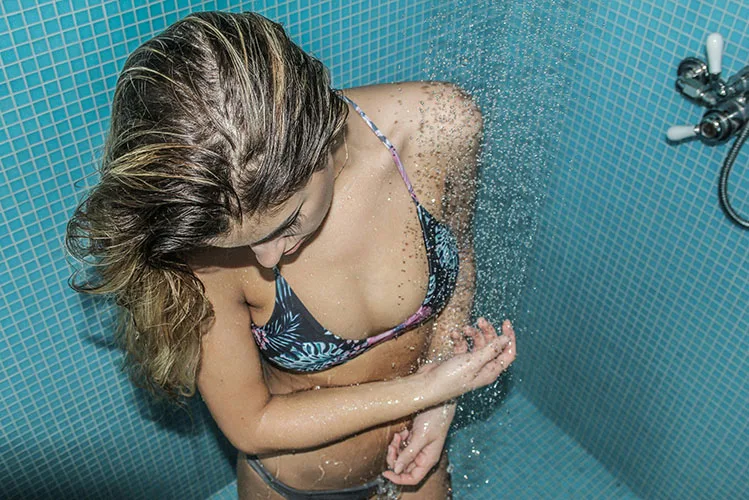The first splash feels brutal.
Cold water slams against your skin, your breath shortens, your chest tightens.
For a split second, you wonder if you’ve made a mistake and your instinct screams to jump out.
For most, that’s enough to turn the dial back to warm.
But if you push through, something else kicks in.
Your body wakes up.
Your mind sharpens.
And the discomfort begins to carry a strange sort of power, the shock transforms into energy.
That uncomfortable moment isn’t just in your head, it’s your body running a powerful survival program.
And understanding what happens inside you during those chilly seconds reveals why so many people are ditching comfort for the cold.
Why we avoid the cold
Warm showers are the default.
They relax muscles, calm nerves, and feel safe.
Cold showers, on the other hand, trigger a primal response: discomfort.
Humans are wired to avoid it.
For most, the idea of voluntarily stepping under icy water feels absurd.
But here’s the twist: the very discomfort we avoid is often the key to growth.
That sting of cold water is a signal that your body is shifting gears, and those shifts can deliver surprising health benefits.
The body’s instant reaction
When icy water touches your skin, your body launches into action:
- Shock breathing. You gasp, and your breathing quickens. This floods your blood with oxygen and fuels your muscles.
- Vessel constriction. Blood vessels tighten, forcing blood to your core to protect vital organs. Once you warm up, vessels expand again, giving your circulation a workout.
- Heart stimulation. Your pulse rises, pumping blood harder and faster. That’s why a cold shower can feel like nature’s version of espresso.
This cascade of reactions isn’t random.
It’s biology’s way of keeping you alive in the cold, and when harnessed safely, it leaves you feeling alert, clear-headed, and alive.
What the science says
Cold exposure isn’t just a fad on social media.
It has real research behind it.
Here’s what studies and practical experience show:
- Immune system boost. A Dutch study found that people who ended showers with cold water reported fewer sick days than those who didn’t. The theory is that cold exposure activates white blood cells, which fight infections.
- Improved circulation. The cycle of vessel constriction and dilation works your cardiovascular system like exercise, keeping it responsive and efficient.
- Muscle recovery. Athletes have long used ice baths to reduce soreness. Cold water lowers inflammation and speeds up recovery after strenuous workouts.
- Mood elevation. Exposure to cold triggers a flood of endorphins and dopamine. Some research even suggests cold showers can help ease mild depression and anxiety.
Science is still catching up to the hype, but the early findings suggest that the benefits are far more than folklore.
Training the mind as well as the body
Beyond biology, cold showers are a mental test.
You’re facing discomfort head-on, which trains resilience.
I remember my first attempt.
Thirty seconds of cold water felt like torture.
But resisting the urge to quit gave me a small daily victory.
That carried over.
Suddenly, I was more disciplined at the gym, more focused at work, and less rattled by stress.
It’s not that cold showers magically fixed everything.
It’s that they taught me how to do something difficult, every single day.
That kind of conditioning builds confidence you carry into the rest of life.
Cold vs warm: when to choose each
This isn’t about declaring one type of shower “good” and the other “bad”.
Both have value:
- Warm showers: Great for evening relaxation, easing muscle tension, or winding down before sleep
- Cold showers: Best for mornings, post-workout recovery, or moments when you need energy and focus
Think of it as a toolset.
Want calm? Go warm.
Need alertness? Go cold.
Many people find balance by starting warm and finishing cold, reaping benefits from both.
How to start without giving up
Jumping straight into two minutes of icy water isn’t realistic for most.
Here’s a beginner-friendly approach:
- Finish cold. Take your normal warm shower. In the last 30 seconds, switch to cold.
- Breathe steady. Focus on deep, slow breaths to calm your body’s panic response.
- Build gradually. Add more time each week until you can last 2–3 minutes.
- Experiment. Try alternating hot and cold, known as contrast showers, which athletes often use for recovery.
Consistency matters more than bravado.
The point isn’t to punish yourself.
It’s to train your body and mind through small, repeated challenges.
Real-world scenarios where cold showers shine
- The morning fog. Instead of reaching for a second coffee, 60 seconds of cold water can jumpstart your alertness.
- Post-workout recovery. Athletes know the anti-inflammatory power of cold. Even a short blast can cut down soreness.
- Stressful days. When your mind feels scattered, cold water acts like a reset button, forcing you back into the present moment.
These aren’t abstract benefits.
You feel them the same day you try them.
Cold showers jolt your body into action, flood you with oxygen, sharpen circulation, and spark mental resilience.
Warm showers relax you, but cold showers challenge you, and growth rarely comes from comfort.
You don’t have to start extreme.
Just finish your shower cold tomorrow morning.
See how your body responds.
The first 20 seconds will feel brutal.
By day seven, you might start looking forward to that shock.
The question is: will you let comfort win, or give your body the wake-up it’s been waiting for?
Tags: cold shower benefits, cold shower vs warm shower, what happens when you take a cold shower, health benefits of cold showers, cold shower for recovery, cold shower for immunity, cold shower for mental health, how to start cold showers, DL006






